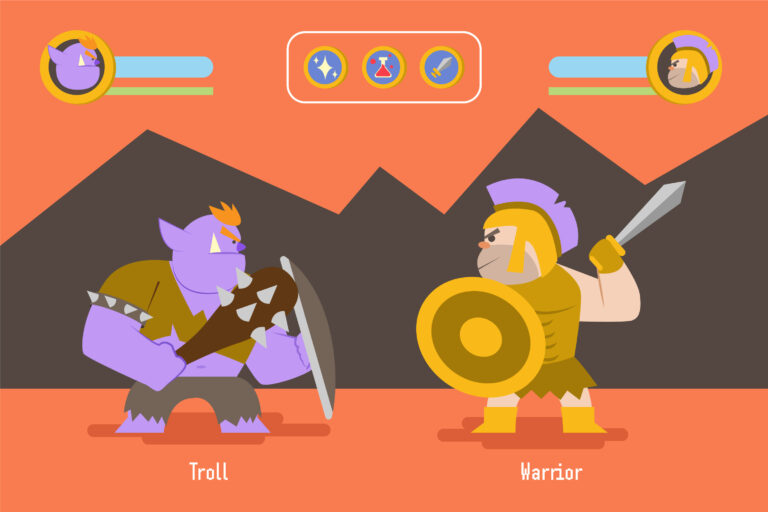VR stands for Virtual Reality, a technology that allows players to step into game worlds rather than watch them on a screen.
By surrounding you with 3D visuals, spatial sound, and motion-tracked controls, it reacts to your movements in real time. Whether you’re flying a spacecraft or wielding a sword, game art studios have utilized VR to make gaming more intense, physically demanding, and emotionally immediate.
In this guide, we will explore how VR gaming works, the necessary equipment, and the notable titles transforming interactive media.


Need Game Art Services?
Visit our Game Art Service page to see how we can help bring your ideas to life!
What Is the VR Definition in Gaming?
Virtual Reality (VR) in gaming refers to a fully immersive, digital environment that users can explore and manipulate using specialized hardware such as headsets, motion sensors, and controllers.
Instead of viewing a character from a third-person perspective, VR literally places you within the game setting. Every tilt of your head or swing of your hand translates directly into action within the game, creating the compelling illusion of being physically present.
This capability has elevated traditional gaming into one of the leading game industry trends that engages sight, sound, and movement simultaneously.
How Does VR Gaming Actually Work?
VR gaming relies on a sophisticated integration of hardware and software that synchronizes your real-world movements with the virtual environment.
Head tracking monitors your line of sight, motion sensors determine your body’s position, and hand controllers register your gestures and button presses.
The game’s engine produces stereoscopic 3D graphics and spatial audio that shift dynamically as you move, convincing your brain that you are experiencing true depth and distance. The outcome is a seamless, 360-degree interactive journey that feels like traversing another realm.
What Are the Main VR Hardware Technologies?
VR hardware serves as the tangible connection between the player and the digital domain. The primary components are:
- Headsets: Generate the 3D environment using dual displays for stereoscopic visuals.
- Controllers: Convert your physical movements into virtual input, often enhanced with tactile haptic feedback.
- Sensors/Trackers: Precisely capture the movement of your head and hands in space, ensuring accurate tracking.
Advanced setups such as the Meta Quest 3, Valve Index, and PlayStation VR2 integrate these parts to provide responsive, near-lifelike immersion with minimal lag.
What Are the Main VR Game Genres and Gameplay Styles?
VR has revitalized classic video game genres while simultaneously pioneering new ones centered around spatial awareness and physical motion.
- Action/Adventure: Titles like Asgard’s Wrath 2 and Half-Life: Alyx combine exploration with deep combat systems.
- Rhythm and Fitness: Supernatural and Beat Saber transform exercise into enjoyable, challenging gameplay.
- Simulation: Flight Simulator VR and Job Simulator allow players to inhabit entirely new roles and scenarios.
- Horror and Survival: Phasmophobia and Resident Evil 4 VR dramatically heighten emotional realism and terror.
Across all genres, the gameplay relies on intuitive, motion-driven mechanics that make the player an essential, physical part of the narrative.
Gameplay Elements
- 360 Environments: Visually survey surrounding scenery in all directions for environmental interaction opportunities.
- Spatial Audio: Sounds occur directionally around the player heightening alertness and environment detection abilities
- Motion controls: Initiative movements with controllers to perform in-game actions from grabbing to casting spells
What Are the Types of VR Gaming Platforms?
VR platforms are typically grouped into two main classes:
- Tethered VR: Requires a connection to a high-powered PC or console to handle complex processing and high-quality graphics (like PlayStation VR2 and Valve Index).
- Standalone VR: Operates autonomously with all computing power built into the headset itself (like Pico 4 and Meta Quest 3).
Tethered systems generally deliver higher performance, while standalone devices prioritize portability and ease of use. The right platform depends on your budget, available space, and desired level of graphical fidelity.
What Software Powers VR Experiences?
The engine behind every virtual adventure is a combination of game engines, middleware, and SDKs (Software Development Kits). Engines like Unity and Unreal Engine provide the necessary frameworks for physics, animation, and real-time rendering optimized for VR.
SDKs such as SteamVR and OpenXR ensure compatibility across various devices, while platform-specific software like the Oculus SDK fine-tunes performance. These tools enable developers to craft highly interactive, seamless experiences that feel both responsive and authentic, regardless of the underlying hardware.
What Are Some of the Best VR Games to Play?
Virtual Reality has given birth to several groundbreaking games that showcase the medium’s vast technical and creative possibilities. Each of these examples highlights a distinct strength of VR: from intricate physics and vast background design to rhythmic challenges and powerful visual storytelling.
Here are some of the most influential titles currently defining the industry:
Half-Life: Alyx
Often hailed as the best VR game ever created, Valve’s Half-Life: Alyx masterfully integrates cinematic game narrative with immersive, physics-based puzzles and detailed hand interactions.
Every single item in the environment reacts realistically, underscoring VR’s incredible potential for deep, believable narrative design.
Beat Saber
Beat Saber achieved widespread popularity in VR by fusing music, movement, and visual rhythm. Players use lightsabers to slice glowing blocks precisely to the beat of high-energy music, turning the game into a captivating, full-body workout.
Its accessible design, fitness benefits, and large modding community make it a fundamental VR title for all players.
Superhot VR
This stylish, minimalist first-person shooter transforms traditional combat into a strategic, slow-motion VR game art.
In Superhot VR, time only advances when you move, forcing players to methodically plan every attack and dodge. Its signature slow-motion physics and clean visuals offer one of the most uniquely cerebral experiences in virtual reality.
No Man’s Sky VR
No Man’s Sky VR converts its expansive, procedurally generated galaxy into a fully realized virtual space. Players can navigate starships, mine resources, and encounter alien life from a completely first-person perspective.
The VR integration dramatically increases the game’s inherent sense of awe and scale, proving VR’s power to enhance open-world design.
Resident Evil 4 VR
Capcom’s Resident Evil 4 VR reinvigorates survival horror through intense first-person immersion. The intuitive, hands-on gunplay and precise spatial audio make every encounter terrifyingly immediate.
It stands as a prime example of how VR can effectively modernize beloved classic franchises, transforming nostalgia into a modern, visceral event.
How to Choose the Right VR Setup
With virtual reality going mainstream, more affordable and capable VR equipment is hitting the market, making it easier than ever before to bring immersive worlds home.
But the number of choices can make it confusing to decide what to buy. Here are some key considerations when selecting your VR gaming gear:
Headset Tech
Prioritize resolution, refresh rate, and field of view (FOV). A minimum refresh rate of 90Hz and a 100° FOV are recommended to minimize motion sickness and maximize realism.
Tracking Capability
Always opt for 6DoF (six degrees of freedom) over 3DoF; this allows for tracking of both your position and rotation, enabling full-room, physically active gameplay.
Ergonomics
Comfort is paramount for extended play sessions. Look for systems with breathable padding, adjustable straps, and balanced weight distribution.
Controller Design
Select controllers that offer accurate motion sensors, responsive haptic feedback, and an intuitive, ergonomic button layout.
Connection Type
Wireless setups grant freedom of movement; wired connections typically ensure more reliable performance. Base your choice on your preferred gaming style and the space you have available.
What Makes the VR Experience So Unique?
The essence of VR’s captivating quality lies in presence: the deep psychological impact of feeling truly “there” in the game world. Through full-body tracking, responsive physics, and precise spatial audio, users don’t merely witness the world; they actively inhabit it.
This unparalleled immersion amplifies emotional responses and strengthens narrative impact, making every session feel unforgettable. After experiencing combat with a virtual dragon or a flight through space in VR, traditional screen-based gaming often feels remote by comparison.
VR vs AR: What’s the Difference?
While Virtual Reality (VR) completely replaces the real environment with a digital one, Augmented Reality (AR) instead superimposes virtual elements onto your actual surroundings.
VR is the standard for immersive gaming, simulation, and high-fidelity training, whereas AR art excels in applications such as industrial design, navigation, and location-based games like Pokémon GO.
Both VR and AR rely on spatial computing, but VR’s purpose is escape and immersion, while AR’s is enhancement and utility. Understanding this difference helps both developers and users select the appropriate technology for their goals.
Final Words
VR gaming has swiftly evolved from a niche novelty into a transformative necessity, fundamentally changing how we interact with digital realities. As hardware becomes lighter and software more sophisticated and adaptive, the distinction between the real and the virtual will continue to dissolve.
Whether you are a gamer exploring new worlds or a developer building them, Virtual Reality represents the most vital and exciting forefront of interactive entertainment. Are you ready to step inside?









